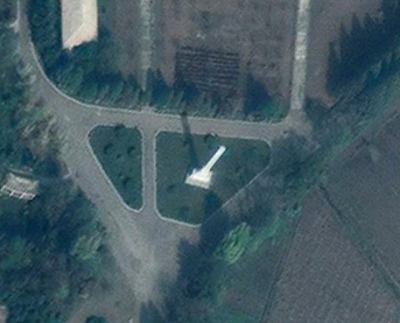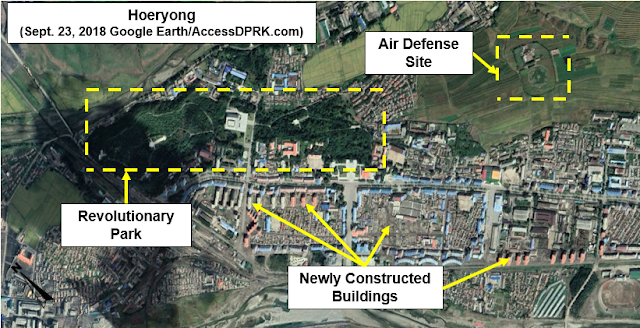Murals of Kim Il Sung and Kim Jong Il at Jangdae Hill, Pyongyang. (Image source: Commons/Nicor/CC 3.0)
Monuments usually mark the place of an important event or memorialize important historical figures. But they can also be used to to enforce the ruling regime. Through murals of the gentle leader playing with children (subtly suggesting the regime controls all ages) to massive monuments declaring the absolute power of the party and state, North Korea uses monuments physically stamp its control across the country.
However, they're more than just symbols of authority with little part in people's everyday lives. Monuments play a central role in ordering society and maintaining control. Wedding photos are taken next to them, locals are required to pay homage to the Kim's at the monuments on holidays and at other times, and their display and proper upkeep (which is required by law) helps to demonstrate loyalty - which in turn can assist in a town or factory in receiving favors from the government.
Various estimates place the number of monuments at up to 34,000. However, the 2017 AccessDPRK Mapping Project, using Google Earth, has established that there is only a fraction of that total in reality. It located 9,896 individual monuments. In 2018 I resurveyed all of those monuments (spending roughly 150 hours on the project). As part of the survey, I classified them by type and was able to located additional monuments. Despite that, I still cannot substantiate the 34,000 estimate and I feel the 2018 survey places restrictions on the maximum number of monuments (it is greater than 10,000, but will not be higher than 15,000, even considering any others I may have possibly missed). With this in consideration, the only realistic interpretation of the 34,000 figure is that it represents the total number of monuments ever constructed, which would include those that have since been demolished, includes memorial plaques (such as on a chair Kim Il Sung may have sat on), or was simply largely based on anecdotal evidence that led to an incorrect figure.
The 2018 review found 11,170 monuments (an increase of 1,274). This increase in number over the original 2017 map can largely be attributed to the erection of new monuments and updated satellite imagery which made seeing them more easy. Regarding new statues in the context of Kim Jong Un, all joint statues and murals of Kim Il Sung and Kim Jong Il are "new" in that they were constructed under the rule of Kim Jong Un. In the new file, I have also pointed out selected other monuments that have been erected since he came to power. In total, there have been at least 410 monuments constructed since 2011.
For this article, I am only focusing on permanent monuments that are made out of stone or metal. There may be upwards of 1,000 propaganda signs, but many are often transient and may be left to deteriorate. Additionally, there are countless wooden signs placed in fields, at construction sites, and other places which promote whatever propaganda theme is being pushed at the time. These signs are likewise often temporary.
To directly download the Google Earth KMZ file, click here. (You must have GE to access the data.)
Monument Types and Identification
North Korea's monuments can be broken down into six main categories: Towers of Immortality, statues of Kim Il Sung and Kim Jong Il, murals of the two Kims, general murals (may feature the Kims, images of daily life, nature, etc.), general monuments and statues (monuments to an event, ones carrying slogans or sayings, non-Kim statues), and large monuments (such as the Juche Tower).
Slogan signs, general murals, and other such monuments all fall within a broader system of generalized monuments and so I haven't given each general monument its own classification label. A key reason for this is the fact that many are small and any detailed identification via satellite is basically impossible. So I have focused on breaking down the monuments into the following major categories: Towers, Kim statues, Kim murals, large monuments, and "others" (which encompasses everything else).
Tower of Immortality on Sungri Street, Pyongyang. (Image source: Commons/Nicor/CC 3.0)
From satellite imagery, Towers look like this
This is the primary Tower of Immortality and is located in Pyongyang.
Towers located in towns and elsewhere, such as in this example, will have a more simple appearance and will be smaller.
This is the Mansudae Grand Monument which features giant bronze statues of Kim Il Sung and Kim Jong Il. While these are the largest statues in the country, smaller statues of the Kim's exist in each provincial capital and at some major institutions.
This is the site as seen on Google Earth.
Murals of Kim Il Sun and Kim Jong Il at Jangdae, Pyongyang. (Image Source: Commons/Nicor/3.0).
From satellite, the murals look like this
Many murals are placed at schools, universities, and factories, and because they are relatively thin (as seen from above), it can be hard to locate them as they may blend in with trees or building facades.
Joint KIS-KJI murals are all labeled within the KMZ file "Others". However it also includes all additional murals, which can have a wide range of images painted on them, as well as slogan monuments, which are typically the smallest kind and has various quotes from the leadership and Party, and larger monuments like the monument to the foundation of Korean Worker's Party and Juche Tower.
This is an example of an institution that has multiple types of monuments around the grounds.
Air Defense and Combat Command, Pyongyang. Base image by Google Earth with annotations by AccessDPRK.com.
Distribution
As a general rule, there's one joint statue of the deceased Kim's in each provincial capital and one joint mural in each county seat. Towers of Immortality are placed in every city, town, and village of note, as well as universities and major factories. In most cases, military bases will not have a monument, but some key military schools, headquarter facilities, and other important bases will have at least one monument.
Final Numbers
North Korea has at least 11,170 monuments, a 13% increase from the 2017 file. Of those, 5,175 are Towers, 29 are joint statues of Kim Il Sung-Kim Jong Il (KIS-KJI), 265 are KIS-KJI joint murals, and 5,701 are various other monuments. While I did not attempt to date every monument erected since Kim Jong Un came into power, I did determine that there are at least 145 of them (representing 1.3% of the total number of monuments in the country). This doesn't include the joint murals, all of which were erected after the death of Kim Jong Il (usually in the place of the single murals of Kim Il Sung that existed prior). If you take those into consideration, then at least 410 monuments are new.
Breakdown by Province
Chagang has 657 total monuments. Of those, there are 346 Towers, 1 is a KIS-KJI statue, and 16 are KIS-KJI murals. There are an additional 294 monuments of various types.
N. Hamgyong has 864 total monuments. Of those, 463 are Towers, 1 is a KIS-KJI statue, and 19 are KIS-KJI murals. There are an additional 381 monuments of various types. There is also an example of a demolished monument (not included in the overall counts).
There are 7 other examples of new monuments (built in 2009 or later)
S. Hamgyong has 1,295 total monuments. Of those, 690 are Towers, 1 is a KIS-KJI statue, and 26 are KIS-KJI murals. There are an additional 578 monuments of various types. There are also 7 example of a demolished monument (not included in the overall counts).
There are 12 other examples of new monuments (built in 2009 or later)
N. Hwanghae has 1,265 total monuments. Of those, 568 are Towers, 3 are KIS-KJI statues, and 25 are KIS-KJI murals. There are an additional 669 monuments of various types. There are also 6 examples of a demolished monument (not included in the overall counts).
There are 16 other examples of new monuments (built in 2011 or later)
S. Hwanghae has 1,254 total monuments. Of those, 667 are Towers, 2 are KIS-KJI statues, and 24 are KIS-KJI murals. There are an additional 561 monuments of various types. There are also 9 examples of a demolished monument (not included in the overall counts).
There are 22 other examples of new monuments (built in 2011 or later)
Kangwon has a total of 1,073 total monuments. Of those, 444 are Towers, 2 are KIS-KJI statues, and 16 are KIS-KJI murals. There are an additional 611 monuments of various types. There are also 3 examples of demolished monuments (not included in the overall counts).
There are 23 other examples of new monuments (built in 2011 or later)
N. Pyongan has 1,252 total monuments. Of those, 637 are Towers, 2 are KIS-KJI statues, and 39 are KIS-KJI murals. There are an additional 574 monuments of various types. There is also an example of a demolished monument (not included in the overall counts).
There are 9 other examples of new monuments (built in 2011 or later)
S. Pyongan has 1,497 total monuments. Of those, 673 are Towers, 4 are KIS-KJI statues, and 54 are KIS-KJI murals. There are an additional 766 monuments of various types. There are also 10 examples of a demolished monument (not included in the overall counts).
There are 32 other examples of new monuments (built in 2011 or later)
Pyongyang has 1,473 total monuments. Of those, 449 are Towers, 11 are KIS-KJI statues, and 21 are KIS-KJI murals. There are an additional 992 monuments of various types. There is also an example of a demolished monument (not included in the overall counts).
There are 20 other examples of new monuments (built in 2011 or later)
Rason has 109 total monuments. Of those, there are 33 Towers, 1 is a KIS-KJI statue, and 2 are KIS-KJI murals. There are an additional 73 monuments of various types. There are also 3 examples of a demolished monument (not included in the overall counts).
Ryanggang has 431 total monuments. Of those, 205 are Towers, 1 is a KIS-KJI statue, and 23 are KIS-KJI murals. There are an additional 226 monuments of various types.
There are 4 other examples of new monuments (built in 2011 or later)
Below shows the ratios of monuments to population.
The population figures are based on the 2008 national census. The annual population growth rate between 1993 and 2008 was 0.84%. That period included a major famine and economic collapse. To estimate current populations, I am going to use growth rate of 10% for the 2008-2018 period, as the economy and food supply situation has improved.
Chagang - 1,429,813 / 657 monuments = 1:2180
N. Hamgyong - 2,560,098 / 864 monuments = 1:2963
S. Hamgyong - 3,372,614 / 1,295 monuments = 1:2604
N. Hwanghae - 2,325,039 / 1,265 monuments = 1:1837
S. Hwanghae - 2,541,533 / 1,254 monuments = 1:2026
Kangwon - 1,625,340 / 1,073 monuments = 1:1514
N. Pyongan - 3,001,528 / 1,252 monuments = 1:2397
S. Pyongan - 4,456,865 / 1,491 monuments = 1:2989
Pyongyang - 3,580,816 / 1,473 monuments = 1:2431
Rason - 216,649 / 108 monuments = 1:2006
Ryanggang - 791,195 / 431 monuments = 1:1835
National population - 25,901,490 / 11,170 monuments = 1:2318
To directly download the Google Earth KML file, click here. (You must have Google Earth to access the information.)
Remember, this file has over 11,000 places marked. The file is broken down by province, so in order to not slow down your computer, click on the province you're interested in, or to view the full file, click on each province one at a time.
Additional Reading
1. The Price of the Cult of Kim, by Jacob Bogle, AccessDPRK (2017)
2. North Korean Cult of Personality, Wikipedia
--Jacob Bogle. 2/27/2019
www.JacobBogle.com
Facebook.com/JacobBogle
Twitter.com/JacobBogle






















































